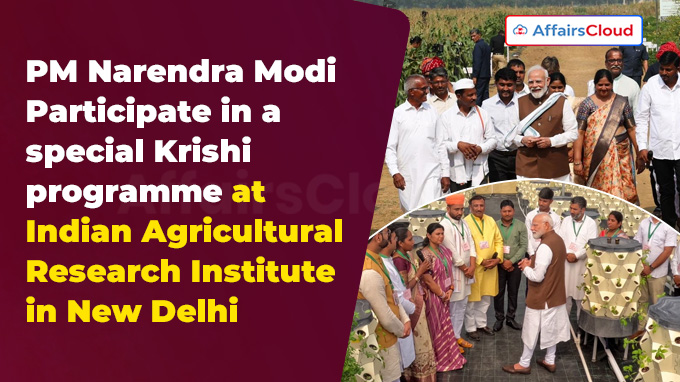In October 2025, Prime Minister (PM) Narendra Modi launched two major schemes ‘PM Dhan Dhaanya Krishi Yojana(PMDDKY)’ and ‘Mission for Aatmanirbharta in Pulses.’ in the agriculture sector under the special Krishi programme, with an outlay of Rs 35,440 crores(cr).
- It was launched during a special Krishi Programme held at the Indian Agricultural Research Institute (IARI) in New Delhi, Delhi.
- PM Narendra Modi also inaugurated and dedicated to the nation projects worth over Rs 5,450 cr in the agriculture, animal husbandry, fisheries, and food processing sectors, and laid the foundation stone for new projects valued at approximately Rs 815 cr.
- During the programme, he also distributed certificates to farmers certified under the National Mission for Natural Farming, MAITRI Technicians, and Primary Agriculture Cooperative Credit Societies (PACS) converted to Pradhan Mantri Kisan Samriddhi Kendras (PMKSKs) and Common Service Centres (CSCs) respectively.
Exam Hints:
- What? Special Krishi Programme launched
- Where? IARI, New Delhi
- Outlay: Rs. 35,440 cr
- PM DDKY:
- Outlay: Rs. 24,000 cr
- Time Period: 6 years from FY26
- Identifies: 100 districts
- Mission for Atmanirbharat in Pulses
- Outlay: Rs.11,440 cr
- Time Period: 2025-26 to 2030-31
- Target Yield: 1130 kg/ha
- Fisheries Projects:
- 7 new projects worth Rs 572 cr (foundation)
- 9 projects worth Rs 121 cr (inauguration)
- Major Projects:
- Trout Fisheries, Uttarakhand – Rs 170 cr
- Smart & Integrated Fishing Harbour, Karaikal – Rs 119.94 cr
- Integrated Aqua Park, Hirakud, Odisha – Rs 100 cr
- Bhubaneswar Wholesale Fish Market, Khorda – Rs 59.13 cr
- Integrated Aqua Park, Nagaland – Rs 50 cr
- ABIS Exports, UP – Rs 70 cr
PM Dhan Dhaanya Krishi Yojana (PM DDKY):
PM DDKY: The scheme is designed to catalyse growth in 100 agri-districts through saturation-based convergence of 36 Central schemes across 11 Ministries, with an annual outlay of Rs. 24,000 cr for a period of six years starting Financial Year 2025–26 (FY26).
Objectives: The 5 core objectives of PM DDKY are:
- Enhancing agricultural productivity.
- Encouraging crop diversification and sustainable agricultural practices.
- Augmenting post-harvest storage capacity at panchayat and block levels.
- Improving irrigation infrastructure for reliable water access.
- Enabling greater access to short-term and long-term agricultural credit for farmers.
Criteria and Selection: The scheme identifies 100 districts based on:
- First, the level of agricultural output per unit of land.
- Second, the number of times crops are cultivated on the same land within a year.
- Third, the availability and extent of institutional loans or investment facilities for farmers.
Inspiration: The schemes are modeled on the Aspirational Districts Programme(ADP).
Mission for Atmanirbharta in Pulses
Outlay: Dalhan Atmanirbharta Mission was also launched with a total outlay of Rs 11,440 crore and will be implemented from 2025–26 to 2030–31.
Objective: The mission aims to achieve self-sufficiency in pulses by significantly enhancing domestic production, reducing import dependence, and sustainably improving farmers’ incomes.
- The Mission plans to expand the area under pulses cultivation by an additional 35 lakh hectares (ha), targeting rice fallows and other suitable lands, while promoting intercropping and crop diversification.
Strategy: To ensure effective implementation, states will prepare rolling five-year seed production plans, with ICAR (Indian Council of Agricultural Research) monitoring breeder seed production and quality assured through the SATHI (Seed Authentication, Traceability & Holistic Inventory) portal.
Post-Harvest: The Mission also seeks to strengthen the post-harvest value chain by establishing 1,000 processing and packaging units, supported by subsidies of up to Rs. 25 lakh per unit, aimed at reducing losses, enhancing value addition, and generating rural employment.
Targets: By 2030–31, the Mission targets expanding pulses cultivation to 310 lakh ha, increasing production to 350 lakh tonnes, and improving yields to 1,130 kg/ha.
- In addition to these production goals, the Mission aims to conserve foreign exchange by reducing imports, promote climate-resilient and soil health-friendly practices, and create substantial employment opportunities.
Fisheries Projects
Overview: During the event, PM Narendra Modi laid the foundation stone for 7 new projects worth Rs. 572 cr and inauguration of 9 fisheries projects worth Rs.121 cr across India under the Pradhan Mantri Matsya Sampada Yojana (PMMSY) and the Fisheries Infrastructure Development Fund (FIDF).
Foundation Stone Laying:
Trout Fisheries project: This project in Uttarakhand under FIDF worth Rs. 170 cr will increase the trout fish production in the region.
Surdib Natural Fishing & Eco Tourism: Approved under FIDF with Rs 3.68 crore, this integrated fish farming and eco-tourism project in Jharkhand aims to boost rural livelihoods sustainably through private entrepreneurship.
Smart & Integrated Fishing Harbour: The Karaikal harbour, in Puducherry, is being developed at Rs 119.94 crore, to ensure safe docking, promote hygienic fish handling, and boost fish production and marketing for both domestic and export purposes.
Integrated Aqua Park (IAP)– Odisha: The park at Hirakud, Sambalpur, Odisha, is a Rs. 100 cr project under the PMMSY aimed at transforming aquaculture through a comprehensive ecosystem.
- Bhubaneswar Wholesale Fish Market: Developed at Rs 59.13 crore in Khorda, the market accommodates 44 wholesalers and 99 retailers, ensuring quality fish supply to Bhubaneswar and Cuttack.
IAP–Nagaland: With an investment of Rs 50 crore, this project focuses on integrated fish farming systems to sustainably enhance fish production.
ABIS Exports (India) Pvt Ltd: With an investment of Rs 70 crore, this FIDF-approved project at Naukhera, Ametihi(Uttar Pradesh, UP), focuses on a sustainable aquaculture nutrition hub
Inauguration:
Assam: Two fish feed plants at Tejpur – Rs 13.00 crore (PMMSY)
UP: State-of-the-art wholesale fish market at Candouli, Varanasi – Rs 61.50 crore (PMMSY)
- 8 RAS units, feed mills, 2 live fish vending centres, kiosks – Rs 2.47 crore (PMMSY)
Madhya Pradesh(MP): 14 projects on ice plants, RAS (Recirculatory Aquaculture System), bio-flocs, transport vehicles, etc. – Rs 5.28 crore (PMMSY)
Haryana: 6 cold storages, 1 ornamental brood bank, 2 feed mills – Rs 11.00 crore (PMMSY)
Andhra Pradesh(AP): Ananda Foods seafood processing facility upgradation – Rs 11crore (FIDF)
Mizoram: Cages, bio-flocs, and hatchery projects – Rs 5.13 crore (PMMSY)
Jharkhand: RAS, bio-floc, cold storage, reservoir cages, feed mill – Rs 4.75 crore (PMMSY)
Chhattisgarh: 16 private projects on cages and bio-floc ponds – Rs 6.92 crore (PMMSY)
Others: PM Narendra Modi also inaugurated several projects, including Artificial Insemination Training Centres in Bengaluru, Karnataka and Jammu & Kashmir (J&K), Centres of Excellence (CoE) at Amreli and Banas, Gujarat
- Other key projects include Milk Powder Plants in Mehsana, Indore, and Bhilwara.
Points to Note:
Pradhan Mantri Matsya Sampada Yojana (PMMSY): It is transformative scheme that was launched on September 2020 by the Ministry of Fisheries, Animal Husbandry & Dairying(MoFAH&D), aims to address critical gaps in fish production and productivity, quality, technology, post-harvest infrastructure and management, and strengthen the value chain.
Fisheries Infrastructure Development Fund (FIDF): The Government of India (GoI) created the FIDF scheme during 2018-19 for creation of various fisheries infrastructures like fishing harbours, fish landing centers, ice plants, cold storage, fish transport facilities, integrated cold chain, modern fish markets.
Rashtriya Gokul Mission (RGM): It was launched by MoFAH&D in December 2014 to develop and conserve indigenous bovine breeds. It focuses on a scientific and holistic approach to improve bovine productivity and increase milk production.





